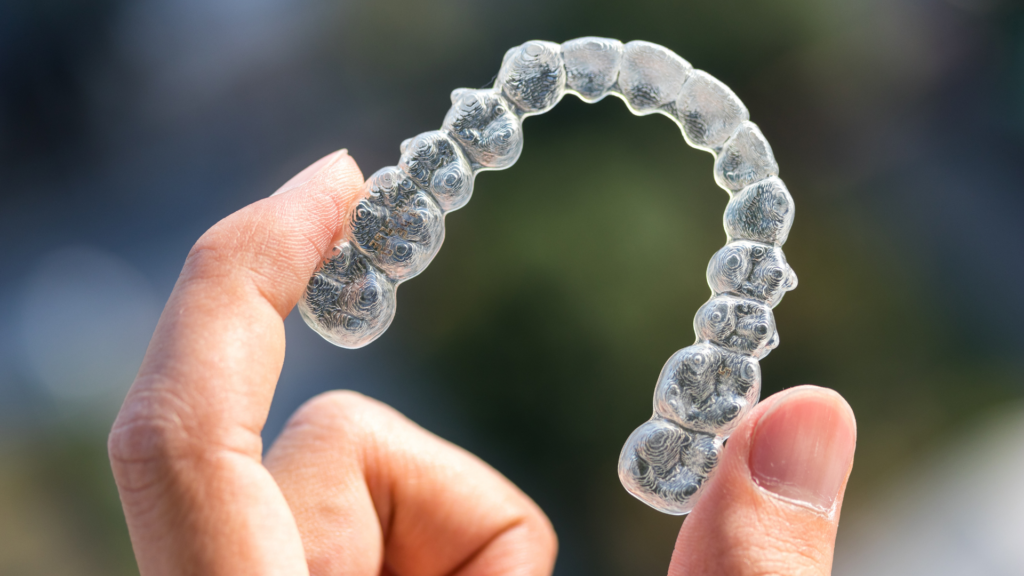If you or your child has ever considered straightening teeth, you have most likely stumbled upon the challenge of deciding between which treatment option is better: traditional metal braces or Invisalign. Well look no further! Clear your “orthodontist near me” Yelp review searches and take a look at the following information we have provided below in detail that will hopefully answer the many questions you may have on straightening teeth.
Let’s get straight to the basics: both traditional braces and Invisalign offer the advantage of attaining a beautiful smile. While we understand that every individual’s definition of a beautiful smile may be different, in dentistry the beauty is defined as the harmonious alignment of the teeth that promotes one’s oral health, allows easy cleaning and cavity prevention, and lastly, produces a bright, joyous smile.
So if both traditional braces and Invisalign have the same goal what makes them so different? The difference lies between your needs and preferences, as every treatment plan is based upon your unique goals set by a collaborative effort between you and your dentist for attaining a beautiful smile.
What should I expect during a consultation appointment?
Before treatment is commenced, a thorough exam and diagnostic information and records will be collected by your dentist during a consultation appointment. These may include extra-and intraoral photographs, radiographs and impressions or scans of your pretty pearly teeth! With all this information in hand, the dentist can then identify your concerns and present to you the best possible treatment options.
Let’s break down the two most common treatment options below and see which one fits your goal for straight teeth!
![]() Metal braces
Metal braces

Traditional metal braces are typically what you think of when you hear the word “braces”. They are fixed metal attachments, called brackets, that are glued onto the surfaces of your teeth and joined together with a continuous wire and small rubber bands. The braces can come in a traditional silver metal color, or there is the option to match the color of the tooth, making them more discrete.
However, if you are looking for a more bold fashion statement, there are many color options to choose from to add a hint of fun to your mouth!
![]() Invisalign
Invisalign

As hinted in the name, these are aligner trays which are BPA-free clear plastics that are removable and only worn for certain time periods during the day. The aligner trays are configured from 3-D imaging to fit your teeth just right. Clear tooth-colored attachments will be placed on the teeth as soft anchors for the aligner trays to allow for the desired movement of the teeth.
What are the advantages of the two?
While both traditional braces and Invisalign achieve the same goal in both straightening teeth and being safe materials in the mouth, they both offer their unique benefits.
Advantages of traditional braces include:
- Fixed appliance – this makes treatment faster and completion of treatment to be at the expected time
- Effective in treating more complex cases – (malocclusion “bad-bite”, overcrowded teeth, crossbites, underbites, and more.)
- Affordable – traditional braces are the most cost-effective option in straightening teeth
- Versatile – braces can come in different colors and can be changed at each appointment if desired
- Durable – the metallic component of braces can withstand the daily wear of chewing and brushing
Advantages of Invisalign include:
- Appearance – Most patients tend to prefer Invisalign because the trays are clear and unnoticable
- Comfort – the aligner trays are customized to your teeth for a more precise, comfortable fit
- Removable – the trays are only in the mouth for 20-22 hours a day and can be taken out when needed to eat and drink
- Less appointments – no need to keep going back to your dentist so often – just every four to six weeks for follow-up appointments
What are the downsides to traditional braces vs. Invisalign?
While it is important to understand the benefits of both treatment options of correcting or straightening your teeth, it is just as noteworthy to weigh possible limitations or disadvantages. To weigh all of the options, below are concerns that may need to be considered:
Some things to consider about traditional braces include:
- Follow-up visits – regular 1 month dental visits are required to monitor tooth movements and replace/tighten the wires
- Hygiene – the wires and brackets may introduce challenges when brushing all surfaces and areas around the teeth, additional aids such as water piks can help in cleaning inaccessible areas in the mouth.
- Food restrictions – some foods may need to be avoided or less frequently ingested to avoid food entrapment (sticky and hard foods)
- Soreness and pain – during follow-up appointments, wires may need to be tightened or elastics may need to be added which can cause pain or discomfort for a few hours
- Appearance – traditional metal brackets can be visibly seen (however, there are tooth colored brackets and also the option to place the brackets behind the teeth
Considerations when it comes to Invisalign include:
- Hygiene – the aligner trays must be removed when eating and drinking to avoid staining
- Removeability – one must be diligent with wearing them for 22 hours a day or as advised by the dentist. In addition, aligners can easily be lost or damaged if not treated properly.
- Initial discomfort – after 10-14 days a patient switches to new aligners which can cause slight discomfort and/or pain.
- Cost – Invisalign is typically the more expensive treatment option when it comes to correcting teeth.
What to expect
So you have already completed your consultation with your orthodontist and chosen the treatment option that addresses your goals on attaining straight teeth for you. What next? The following describes what to expect on the first day of your appointment for both traditional metal braces and Invisalign.

Application of traditional braces
The dentist will use a retractor to prop your mouth open comfortably and allow the mouth to be dry so that the brackets can be applied. The dentist will then prepare your tooth by cleaning the top surfaces with a solution and then rinse it off. After, a special bracket adhesive will be applied on each tooth and then the bracket will be placed on the adhesive. The dentist will clean any excess glue and “cure” the bracket in place with a special blue light. After all the brackets have been secured into place the wire will be placed through the slots that are on the bracket. There are two ways the wires can be secured into place. One being the ‘self-ligating’ brackets which lock the wire into place with a clip. The other does not have a clip and therefore the wire will be secured using a tiny rubber band which comes in different colors (and also clear if preferred).
And done! The dentist will then deliver some instructions on how to brush and floss your teeth with the new braces in and review any at home instructions to you. After they have explained everything to you this would be a great time to ask any questions you may still have.
Application of Invisalign
The dentist will use a retractor to prop your mouth open comfortably and allow the mouth to be dry so that the attachments can be applied.The dentist will then prepare your tooth by cleaning the top surfaces with a solution and then rinse it off. After, a special adhesive will be applied in the aligner trays which will then be placed on the teeth and “cured” with a special blue light.
Once all of the attachments have been secured into place and the adhesive has been cured, any excess material will be removed. This will be your first aligner and will not be an exact fit but do not worry, that’s the plan so that the teeth move to fit with the aligner. It will snap into place as the aligner tray engages with the attachments that were just placed on your teeth. Your dentist will then instruct you on how to place your aligners in and how to take them out. Brushing and flossing your teeth will be the same as you do not keep the aligner trays in when you are brushing your teeth. Your dentist will deliver at-home instructions and duration times for each tray. Typically, you will be given 3-4 trays to change at home at given intervals (after 10-14 days, switch to the next tray, and so on..) Be sure to ask any questions you may have.
Now that we have listed all the important factors to consider when choosing between traditional braces and Invisalign trays. The final decision rests on you with the recommendations set by your orthodontist. Visit your local dental professional with specific needs and concerns so that they can be thoroughly addressed at your next appointment.
Frequently asked questions about correcting/straightening teeth:
- When is the best time to seek an opinion on whether I or my child am a good candidate for traditional braces and/or Invisalign?
- The sooner the better! For adults consult with your local dentist or orthodontist on whether braces or Invisalign will be a great option for you. Consultation appointments are typically complimentary.
- For parents concerned about their child’s misalignment of teeth, the American Association of Orthodontists (AAO) recommends your child visit an orthodontist before the age of 7 years old for an initial check-up. That way, if a problem does exist your orthodontist will be able to guide your child towards a recommended treatment.
- How long does treatment last?
- Every patient is unique therefore treatment durations will vary from patient to patient. Simple cases of corrections may even take months; however, typically treatment may range from 18-24 months with both traditional braces and Invisalign.
- My child still has baby teeth. Why should I go before the age of 7?
- Your child’s baby teeth give orthodontists a great deal of information! They indicate your child’s development and how their permanent teeth will be. So
getting your child in early to see an orthodontist as soon as possible will allow for any necessary intervention
- Can I get braces if I have crowns or root canals?
- Yes, it is possible to receive treatment. Materials are available to adhere orthodontic brackets to crowns just like you would any other tooth. For specific circumstances and questions, consult with your local orthodontist.
- Is there anything I need to do before getting braces or Invisalign
- Yes, before you get treatment visit your local dentist for a check-up and cleaning. Typically, we would like all cavities and necessary cleanings done so corrective treatment can start. You should also continue to visit your dentist during treatment to optimize your oral health!
- If I get traditional metal braces set off the metal detectors in the airport?
- No, your braces are safe to fly. No need to be alarmed!
- I am afraid of needles. Will I need an injection to straighten my teeth?
- No. No anesthesia is required for teeth correcting procedures For more information, visit The American Association of Orthodontists here.

Comments are closed